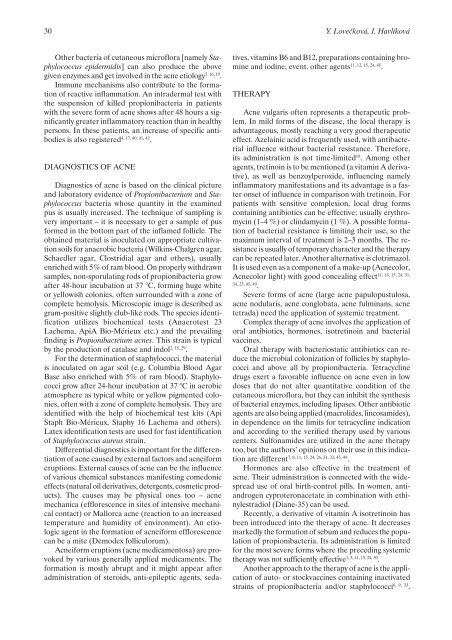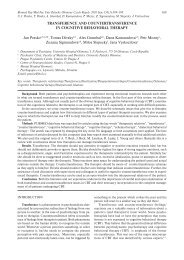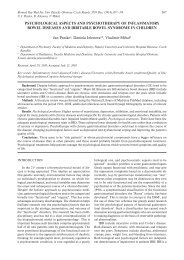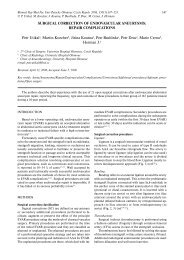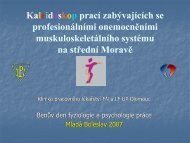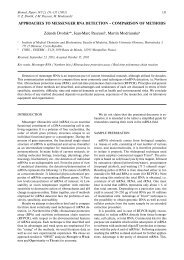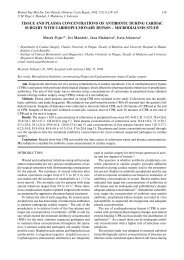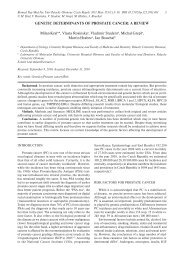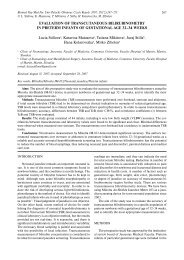A MICROBIOLOGICAL APPROACH TO ACNE VULGARIS Yvona ...
A MICROBIOLOGICAL APPROACH TO ACNE VULGARIS Yvona ...
A MICROBIOLOGICAL APPROACH TO ACNE VULGARIS Yvona ...
You also want an ePaper? Increase the reach of your titles
YUMPU automatically turns print PDFs into web optimized ePapers that Google loves.
30Y. Lovečková, I. HavlíkováOther bacteria of cutaneous microflora [namely Staphylococcusepidermidis] can also produce the abovegiven enzymes and get involved in the acne etiology 5, 16, 19 .Immune mechanisms also contribute to the formationof reactive inflammation. An intradermal test withthe suspension of killed propionibacteria in patientswith the severe form of acne shows after 48 hours a significantlygreater inflammatory reaction than in healthypersons. In these patients, an increase of specific antibodiesis also registered 4, 17, 40, 41, 42 .DIAGNOSTICS OF <strong>ACNE</strong>Diagnostics of acne is based on the clinical pictureand laboratory evidence of Propionibacterium and Staphylococcusbacteria whose quantity in the examinedpus is usually increased. The technique of sampling isvery important – it is necessary to get a sample of pusformed in the bottom part of the inflamed follicle. Theobtained material is inoculated on appropriate cultivationsoils for anaerobic bacteria (Wilkins-Chalgren agar,Schaedler agar, Clostridial agar and others), usuallyenriched with 5% of ram blood. On properly withdrawnsamples, non-sporulating rods of propionibacteria growafter 48-hour incubation at 37 °C, forming huge whiteor yellowish colonies, often surrounded with a zone ofcomplete hemolysis. Microscopic image is described asgram-positive slightly club-like rods. The species identificationutilizes biochemical tests (Anaerotest 23Lachema, ApiA Bio-Mérieux etc.) and the prevailingfinding is Propionibacteium acnes. This strain is typicalby the production of catalase and indol 2, 15, 29 .For the determination of staphylococci, the materialis inoculated on agar soil (e.g. Columbia Blood AgarBase also enriched with 5% of ram blood). Staphylococcigrow after 24-hour incubation at 37 °C in aerobicatmosphere as typical white or yellow pigmented colonies,often with a zone of complete hemolysis. They areidentified with the help of biochemical test kits (ApiStaph Bio-Mérieux, Staphy 16 Lachema and others).Latex identification tests are used for fast identificationof Staphylococcus aureus strain.Differential diagnostics is important for the differentiationof acne caused by external factors and acneiformeruptions. External causes of acne can be the influenceof various chemical substances manifesting comedoniceffects (natural oil derivatives, detergents, cosmetic products).The causes may be physical ones too – acnemechanica (efflorescence in sites of intensive mechanicalcontact) or Mallorca acne (reaction to an increasedtemperature and humidity of environment). An etiologicagent in the formation of acneiform efflorescencecan be a mite (Demodex folliculorum).Acneiform eruptions (acne medicamentosa) are provokedby various generally applied medicaments. Theformation is mostly abrupt and it might appear afteradministration of steroids, anti-epileptic agents, sedatives,vitamins B6 and B12, preparations containing bromineand iodine, event. other agents 11, 12, 15, 24, 45 .THERAPYAcne vulgaris often represents a therapeutic problem.In mild forms of the disease, the local therapy isadvantageous, mostly reaching a very good therapeuticeffect. Azelainic acid is frequently used, with antibacterialinfluence without bacterial resistance. Therefore,its administration is not time-limited 19 . Among otheragents, tretinoin is to be mentioned (a vitamin A derivative),as well as benzoylperoxide, influencing namelyinflammatory manifestations and its advantage is a fasteronset of influence in comparison with tretinoin. Forpatients with sensitive complexion, local drug formscontaining antibiotics can be effective; usually erythromycin(1–4 %) or clindamycin (1 %). A possible formationof bacterial resistance is limiting their use, so themaximum interval of treatment is 2–3 months. The resistanceis usually of temporary character and the therapycan be repeated later. Another alternative is clotrimazol.It is used even as a component of a make-up (Acnecolor,11, 14, 15, 24, 31,Acnecolor light) with good concealing effect34, 25, 45, 49.Severe forms of acne (large acne papulopustulosa,acne nodularis, acne conglobata, acne fulminans, acnetetrada) need the application of systemic treatment.Complex therapy of acne involves the application oforal antibiotics, hormones, isotretinoin and bacterialvaccines.Oral therapy with bacteriostatic antibiotics can reducethe microbial colonization of follicles by staphylococciand above all by propionibacteria. Tetracyclinedrugs exert a favorable influence on acne even in lowdoses that do not alter quantitative condition of thecutaneous microflora, but they can inhibit the synthesisof bacterial enzymes, including lipases. Other antibioticagents are also being applied (macrolides, lincosamides),in dependence on the limits for tetracycline indicationand according to the verified therapy used by variouscenters. Sulfonamides are utilized in the acne therapytoo, but the authors’ opinions on their use in this indicationare different 7, 8, 11, 15, 24, 26, 31, 32, 45, 49 .Hormones are also effective in the treatment ofacne. Their administration is connected with the widespreaduse of oral birth-control pills. In women, antiandrogencyproteronacetate in combination with ethinylestradiol(Diane-35) can be used.Recently, a derivative of vitamin A isotretinoin hasbeen introduced into the therapy of acne. It decreasesmarkedly the formation of sebum and reduces the populationof propionibacteria. Its administration is limitedfor the most severe forms where the preceding systemictherapy was not sufficiently effective 1, 3, 11, 15, 24, 30 .Another approach to the therapy of acne is the applicationof auto- or stockvaccines containing inactivatedstrains of propionibacteria and/or staphylococci 6, 9, 33 .


